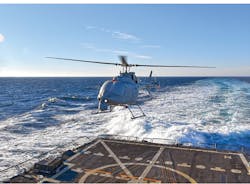Arete supports multispectral UAV sensor payloads to find hidden mines on invasion beaches
PANAMA CITY, Fla. - Electro-optics experts at Arete Associates in Tucson, Ariz., are increasing their support of a project to design multispectral UAV sensor payloads to help military unmanned helicopters detect and pinpoint mines and obstacles to help keep Marines safe during amphibious attacks.
The Navy MQ-8C unmanned helicopter will carry multispectral sensor payloads to help detect and pinpoint mines and obstacles in beach surf zones.
Officials of the U.S. Naval Surface Warfare Center Panama City Division in Panama City, Fla., announced a $7.5 million contract modification to Arete to support AN/DVS-1 Coastal Battlefield Reconnaissance and Analysis (COBRA) block 1 system for the Littoral Combat Ship (LCS) mine-countermeasures mission.
Carried on the Navy Northrop Grumman MQ-8B Fire Scout, the sensor system has limited detection capability in the surf zone. The COBRA system enables operators and personnel to remain at safe distances from mines and other obstacles. COBRA will deploy from the littoral combat ship and is an integral part of the ship's mine countermeasures mission package.
This order is to provide COBRA program systems support for the AN/DVS-1 COBRA Block 1 system and support equipment. Eventually the COBRA system also will go aboard the larger and longer-range MQ-8C Fire Scout unmanned helicopter.
COBRA uses multispectral sensors to conduct unmanned aerial tactical reconnaissance to detect and localize mine fields and obstacles in the surf zone and beach zone prior to amphibious assault. The COBRA payload includes a stabilized step stare digital gimbal, high-resolution multispectral imaging digital camera with spinning six-color filter wheel, a processing unit, and solid-state data storage.
Arete Associates first won a contract in March 2011 to build three COBRA Block 1 low-rate initial production systems. COBRA Block I, tested and validated in 2010, is a passive system with capabilities of daytime surface-laid mine line and obstacle detection in the beach zone, limited detection capability in surf zone, and off-board processing.
BAE Systems Spectral Solutions in Honolulu is developing a prototype for the COBRA Block II program.
Arete Associates will do the work in Tucson, Ariz., and should be finished by December 2018.
For more information visit Arete Associates online at http://arete.com.

